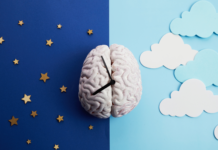Restless nights, filled with unrewarding sleep, are experienced by at least one third of the population. About ten percent suffer so severely for long stretches of time that they fulfill diagnostic criteria for insomnia disorder. Their experience is marked by frequent difficulty falling asleep at bedtime, resuming sleep after waking up during the night, or waking up too early in the morning. The pattern is present at least three nights a week, and persists at least three months even if the circumstances and opportunities for sleep are ideal. Moreover, they must report problems with daytime functioning or wellbeing, which they attribute to their poor sleep quality.
Restless nights and listless days are more frequent with advanced age and in those with neuropsychiatric illness. Examples are neurodegenerative disorders including Alzheimer’s and Parkinson’s disease, as well as mood, anxiety and stress-related disorders.
Several studies have examined whether bright light exposure can ameliorate restless nights and listless days. The historic rationale behind this intervention has been the well-known action of light on the biological clock, located in the hypothalamic suprachiasmatic nucleus (SCN) with input from the optic nerves. The clock orchestrates the circadian rhythm of all physiology and behavior that varies with day and night, including sleep and wakefulness. While the responsible clump of neurons in the SCN can indeed function as a self-sustaining clock, it would easily lose synchrony with day and night if not regularly reset by environmental light. Thus, light to the eyes underlies more than visual sensory experience. Indeed, specialized light-receptive cells in the retina send signals to the biological clock, telling it when it is day and when it is night. By informing the clock about solar time, light serves to keep day-night rhythms in sync with the outside world.
More recently, these retinal cells were also found to signal other clumps of neurons in the brain distinct from those controlling the clock or creating visual images. Rather, these neurons are specifically involved in sleep (the hypothalamic ventrolateral preoptic nucleus) and mood (the thalamic habenula). By acting on these neurons, light appears to help maintain good sleep and balanced emotions, respectively.
A deficit in light exposure does not necessarily underlie complaints of insomnia. Light enhancement can be helpful even in normal lighting environments. “More than usual” light exposure may benefit people with certain vulnerabilities, at certain times, and in certain contexts.
For example, the biological clock is clearly affected by aging and Alzheimer’s disease, and a better lit daycare environment can alleviate nocturnal restlessness and depressive mood in institutionalized demented elderly people. It is not as clear whether there is damage to the clock in Parkinson’s disease, where a trial of bright light alleviated only subjective sleep complaints but not depressive symptoms. There is even less evidence for major involvement of the clock in insomnia disorder; indeed, bright light as monotherapy is insufficient to resolve sleep complaints. By contrast, bright light added as an adjunct to cognitive behavioral therapy for insomnia prolongs the positive response.
Most studies to date have evaluated the effects of bright white or blue light, with red light serving as an inactive control condition. Recent findings, however, indicate that intense red light can induce sleepiness during subsequent darkness, which suggests that it could serve effectively as a preparatory nightcap.
Finally, when evaluating the effects of light on sleep and mood, it is important to consider the different time scales of action. For example, the lack of joy, or anhedonia, experienced by people with insomnia improves instantly in a brighter environment. On the other hand, it took months before beneficial effects of bright light were fully expressed in people with dementia. Taken together, these findings should encourage us to integrate sufficient exposure to bright light in everyday life.
Eus Van Someren PhD leads the sleep group at the Netherlands Institute for Neuroscience, and is professor at the VU University and Medical Center in Amsterdam. His research focuses on brain mechanisms of insomnia, with the aim of improving treatment, which can include bright light.






